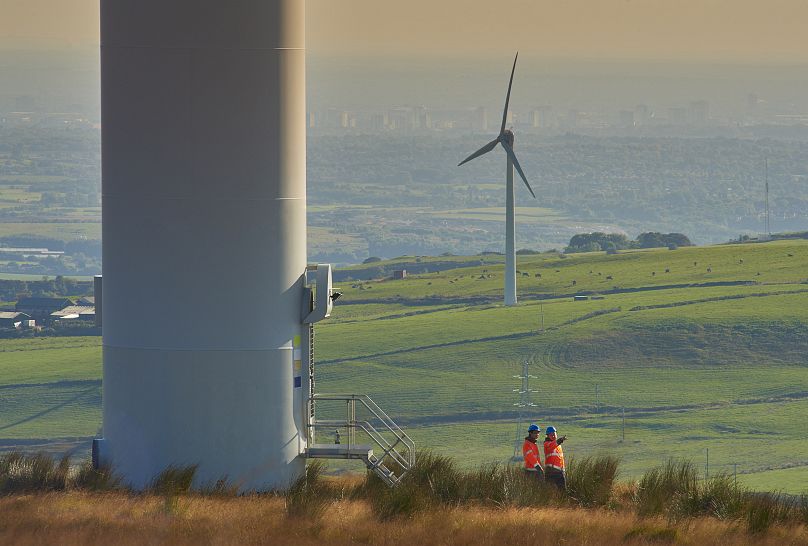Climate data: the new key for finance decision making
In a changing climate, the financial sector will more than ever need precise data, predictions and projections to assess investment risks and identify opportunities. Having reliable information at hand will help to accelerate the switch to a climate-resilient global economy.
Recent years have seen the financial sector under pressure to help deliver climate adaptation and mitigation actions and make greener investment decisions. Now, with the world contemplating a post-pandemic green recovery, expectations are mounting for banks and investors to drive that greening in more transparent ways.
Keeping dangerous warming below 1.5 °C and achieving net-zero emissions by 2050 comes at a long-term price. According to the UN, globally, we need to invest between $5 and $7 trillion per year to achieve the Sustainable Development Goals (SDGs) to combat global challenges such as climate change – far from the estimated $3 trillion per year currently discussed. However, financial institutions “need to respond to the fact that climate risk has become an investment risk,” Philip Hildebrand, vice chairman of BlackRock, one of the world’s largest asset managers, said at the World Economic Forum in Davos in January.
Boosting investments in low-carbon projects and industries can mainstream decarbonisation and discourage growth in carbon-intensive sectors. But to clean up its portfolios, the financial sector must understand better how climate change affects its current and future assets and how it can drive down its environmental impact. Getting to grips with climate information is part of the task.
“When people talk about green finance, one big part is helping to reduce CO2 emissions, investing in green tech, disinvesting in brown tech,” says Harilaos Loukos, founder of the Climate Data Factory, an online provider of ready-to-use climate data. “The other one is adaptation – how can finance help increase the resilience of our societies, how do you finance adaptation plans, etc.” Whether financial institutions do one or the other, or both, evaluating financial climate risks becomes fundamental.
Assessing financial risks in the future will rely heavily on climate data
The financial sector is now focusing on two main types of financial climate risks: transitional and physical. The first ones result from changes in society and businesses as they adjust to a low-carbon economy. Physical risks refer to the consequences of future climate conditions and their financial impacts. “They are two sides of the same coin,” says Romain Hubert, a project manager who focuses on integrating physical climate risks in finance at the Institute for Climate Economics (I4CE), a Paris-based think tank supporting action on climate change. “In both cases, banks, investors, asset managers, insurance companies want to know how these climate-related issues will affect people, companies or governments, and their ability to pay back loans, provide financial returns to investors, or lead to increased insurance claims.”
“There might be direct risks to people, ecosystems or infrastructure, or remote risks to their supply chains,” says Dr. Samantha Burgess, deputy director of the Copernicus Climate Change Service (C3S). Risks come from extreme hazards, such as heavy rainfalls, floodings, heatwaves, storm surges, or droughts, as well as from long-term changes in climate. Overall, the total value of assets exposed to climate change risks has been estimated to reach up to $43 trillion by 2100, according to the Economist Intelligence Unit. “Sadly, financial impacts of climate change are not yet appropriately assessed, valued, reported and disclosed to the public. Developing best practice ‘baselines’ for using climate data to evaluate current and potential risks is incredibly important to ensure resilience of future investments,” Dr. Burgess adds.
A few years back, the sector viewed climate change as too distant to be included in financial decision making. But nudging the finance sector to be more transparent about its climate risks has been on the rise. Set up in 2015, the Task Force on Climate-related Financial Disclosures (TCFD) develops recommendations for disclosing climate-related financial risks that companies face. These recommendations for use by companies, banks and investors can help institutions inform their decision-making in the areas of governance, strategy, risk management, metrics and targets.
While the TCFD does not impose on companies to report climate risks, C3S’s Dr. Burgess sees it as an emerging standard that will ensure businesses report their climate change exposure. But evaluating those risks requires the financial sector to engage with complex climate information, which so far, except for insurers, has been out of the sector’s scope.
Copernicus and the Climate Data Factory to launch tools for financial institutions
“One of the issues is that people have a hard time accessing the data,” says Loukos, founder of the Climate Data Factory. “That is where we work with C3S to help the financial sector by linking the available data to their demands.” C3S and the Climate Data Factory’s pilot project is putting together a dataset of climate hazards that helps financial actors assess their physical climate risks in line with TCFD recommendations. The project – discussed in detail in a recent webinar – uses climate data from C3S’s Climate Data Store and helps corporations understand different climate scenarios and the uncertainty of climate models. It also tries to provide corporations with data comparable across the world. “For example, the Dutch have very high-resolution flooding data, but if you’re a large corporation with assets in the Netherlands and other regions, you will not have the same type of data,” Loukos explains. “We try to provide data and a global view that can be used across regions.”
Different types of uncertainty can obstruct evaluations. “One uncertainty is about which future emissions scenario you use,” explains Loukos, “the business-as-usual, or that in line with the Paris Agreement?” On top of that, there is uncertainty related to climate evolution under each scenario. By using multiple climate models for each individual scenario, the C3S pilot project also allows to assess this aspect of uncertainty, providing a fuller picture of future climate risk.
Under ClimINVEST, investors and climate scientists have been working together to produce methodologies for evaluating risk from climate hazards, asset exposure and vulnerability, while looking at the impacts affecting companies – from physical to financial ones. “It helps build mutual understanding between climate experts and financial actors on their capacities and needs, as well as prioritise their efforts,” says Dr. Hubert, who works with ClimINVEST at the Institute for Climate Economics.
Financial and environmental benefits could come together in the future
But managing one’s financial climate risks is not the same as reducing one’s environmental impact. In other words, explains Remco Fischer, climate change programme officer for the Finance Initiative of UN Environment (UNEP-FI), an investor managing well their climate-related risks is not necessarily a green investor, as their action might not help reduce emissions.
UNEP-FI is among the organisations supporting the finance sector to adopt the Task Force on Climate-related Financial Disclosures (TCFD) recommendations. “But to us, TCFD is just the start of the journey,” says Fischer. “We need to get banks to set environmental targets for their entire portfolios.” He says this ask would have been hard to imagine five years ago, but growing concerns about climate change have built momentum for getting the financial sector on board.
And they are getting on board. To date, under the UN-convened Net-Zero Asset Owner Alliance, 33 institutional investors with assets worth $5.1 trillion have pledged to transition their investment portfolios to net-zero greenhouse gas emissions by 2050. The TCFD’s 2020 report also shows that more than half of the world’s largest 100 public companies support the Task Force and align with its guidelines. But it also shows that climate-risk disclosures are still too slow, increasing only by six per cent between 2017 and 2019.
In the EU, a 2019 directive aimed at non-financial information, requires the finance sector to disclose their environmental protection policies. But Fischer would like to see mandatory climate-related financial disclosures that also require environmental impact disclosures. He would also like to see companies set science-based targets for cutting emissions. “The target you are setting yourself should be consistent with what the science says should happen to the economy – how much each sector has to reduce, and within them, how much each company has to do.”
To conclude, the fact that New Zealand has already made climate disclosures mandatory might also pave the way for other countries to follow suit, according to C3S’s Dr. Burgess. And if that happens, having reliable, traceable climate data becomes essential.
Source: https://www.euronews.com/2021/02/26/climate-data-the-new-key-for-finance-decision-making




